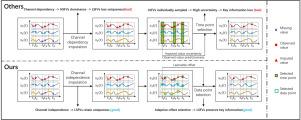LFVDNet: Low-frequency variable-driven network for medical time series
IF 4.5
2区 医学
Q2 COMPUTER SCIENCE, INTERDISCIPLINARY APPLICATIONS
引用次数: 0
Abstract
Objective:
Medical time series, a type of multivariate time series with missing values, is widely used to predict time series analysis, the “impute first, then predict” end-to-end architecture is used to address this issue. However, existing methods are likely to lead to the loss of uniqueness and key information of low-frequency sampled variables (LFSVs) when dealing with them. In this paper, we aim to develop a method that effectively handles LFSVs, preserving their distinctive characteristics and essential information throughout the modeling process.
Methods:
We propose a novel end-to-end method named Low-Frequency Variable-Driven network (LFVDNet) for medical time series analysis. Specifically, the Time-Aware Imputer (TA) module encodes the observed values and critical time information, and uses the attention mechanism to establish an association between the observed values and the missing values. TA adopts channel-independent strategy to prevent interference from high-frequency sampled variables (HFSVs) on LFSVs, thereby preserving the unique information contained in LFSVs. The Offset-Selection Module (OS) independently selects data points for each variable through offsets, avoiding the natural disadvantages of LFSVs in selection-based imputation, thus solving the problem of the loss of key information of LFSVs. LFVDNet is the first method for analyzing multivariate time series with missing values that emphasizes the effective utilization of LFSVs.
Results:
We carried out the experiments on four public datasets and the experimental results indicate that LFVDNet has better robustness and performance. All code is available at https://github.com/dxqllp/LFVDNet.
Conclusions:
This study proposes a novel method for medical time series analysis, namely LFVDNet, which aims to effectively utilize LFSVs. Specifically, we have designed the TA module, which performs imputation through temporal correlations. The OS module, on the other hand, performs selective imputation based on a data point selection strategy. We have verified the effectiveness of this method on four datasets constructed from PhysioNet 2012 and MIMIC-IV.

LFVDNet:医疗时间序列的低频变量驱动网络。
目的:医学时间序列作为一种多变量时间序列的缺失值预测被广泛应用于时间序列分析,采用“先估算后预测”的端到端架构解决这一问题。然而,现有的方法在处理低频采样变量(LFSVs)时,容易导致其唯一性和关键信息的丢失。在本文中,我们的目标是开发一种有效处理LFSVs的方法,在整个建模过程中保留其独特的特征和基本信息。方法:提出一种新的端到端医学时间序列分析方法——低频变量驱动网络(LFVDNet)。具体来说,TA (time - aware Imputer)模块对观测值和关键时间信息进行编码,并利用注意机制在观测值和缺失值之间建立关联。TA采用信道无关策略,防止高频采样变量(HFSVs)对LFSVs的干扰,从而保留了LFSVs中所包含的唯一信息。偏移选择模块(Offset-Selection Module, OS)通过偏移量独立选择每个变量的数据点,避免了LFSVs在基于选择的插值中固有的缺点,从而解决了LFSVs关键信息丢失的问题。LFVDNet是第一个强调lfsv有效利用的多变量缺失值时间序列分析方法。结果:我们在四个公共数据集上进行了实验,实验结果表明LFVDNet具有更好的鲁棒性和性能。本文提出了一种新的医学时间序列分析方法,即LFVDNet,旨在有效地利用lfsv。具体而言,我们设计了TA模块,该模块通过时间相关性进行imputation。另一方面,操作系统模块根据数据点选择策略执行选择性插补。我们在PhysioNet 2012和MIMIC-IV构建的四个数据集上验证了该方法的有效性。
本文章由计算机程序翻译,如有差异,请以英文原文为准。
求助全文
约1分钟内获得全文
求助全文
来源期刊

Journal of Biomedical Informatics
医学-计算机:跨学科应用
CiteScore
8.90
自引率
6.70%
发文量
243
审稿时长
32 days
期刊介绍:
The Journal of Biomedical Informatics reflects a commitment to high-quality original research papers, reviews, and commentaries in the area of biomedical informatics methodology. Although we publish articles motivated by applications in the biomedical sciences (for example, clinical medicine, health care, population health, and translational bioinformatics), the journal emphasizes reports of new methodologies and techniques that have general applicability and that form the basis for the evolving science of biomedical informatics. Articles on medical devices; evaluations of implemented systems (including clinical trials of information technologies); or papers that provide insight into a biological process, a specific disease, or treatment options would generally be more suitable for publication in other venues. Papers on applications of signal processing and image analysis are often more suitable for biomedical engineering journals or other informatics journals, although we do publish papers that emphasize the information management and knowledge representation/modeling issues that arise in the storage and use of biological signals and images. System descriptions are welcome if they illustrate and substantiate the underlying methodology that is the principal focus of the report and an effort is made to address the generalizability and/or range of application of that methodology. Note also that, given the international nature of JBI, papers that deal with specific languages other than English, or with country-specific health systems or approaches, are acceptable for JBI only if they offer generalizable lessons that are relevant to the broad JBI readership, regardless of their country, language, culture, or health system.
 求助内容:
求助内容: 应助结果提醒方式:
应助结果提醒方式:


